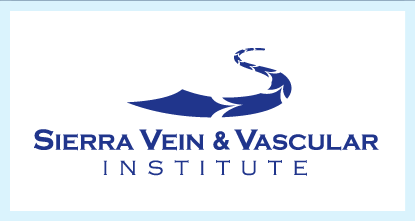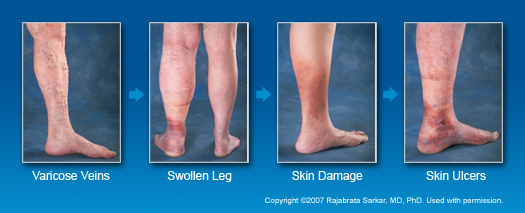Varicose Veins
The field of venous disease is not well understood by the public or even many medical professionals. In the real world, vein problems are too often managed poorly. Varicose Veins are often the result of an underlying disorder of the circulatory system called venous reflux or insufficiency. Veins are an integral part of the circulatory system as are the heart and the arteries. Veins deserve the specialized care offered by a Cardiovascular Surgeon through the training, knowledge, and experience gained in treating vascular disorders. Developments in this field have been dramatic during the past decade and ongoing new research has lead to better understanding and treatment of venous disease.
Approximately 25 million suffer from symptomatic varicose veins in America. It is estimated that in America, 72% of women and 42% of men will experience varicose veins by the time they are in their 60s.
Patients with lower extremity vein disease can have a variety of symptoms, some of which may not be typical of varicose veins. Additionally, these symptoms may be present even if patients have no visual evidence of varicose veins. Some typical findings associated with varicose veins may include swelling in legs, discoloration around the ankles, or leg ulcers. Other not so typical symptoms include heavy, tired, restless or achy feelings in legs. Some may have fatigue and tightness in calves. Others may have sensations of burning or itching.
The Underlying Cause: Superficial Venous Reflux
Superficial venous reflux disease is the leading cause of varicose veins and is caused by incompetent or "leaky" valves in the vein running from foot to groin. This condition can be progressive and symptoms may worsen with time. Left untreated, it can lead to chronic, debilitating, and sometimes limb-threatening conditions. Worsening symptoms frequently force patients to dramatically change their lifestyles, especially when they have standing professions and can no longer tolerate being on their feet all day.
Veins have one-way valves which channel and direct the blood back to the heart and prevent backflow or reflux of blood. When the valves are working properly, blood flows up towards the heart. When the valves leak, gravity causes the blood to return back to the feet. These leaky or insufficient valves are the underlying mechanism of varicose vein disease. The reversal of blood flow forces veins to progressively enlarge to varicosities. During long periods of standing or sitting, the blood in leg veins can pool to increase the pressure within the veins. Over time, vein walls weaken and dilate. This unhealthy circulatory pattern leads to lower extremity tissue damage, swelling, dermatitis, and ulceration. As the blood is not flowing, the varicosities may clot and cause phlebitis, or they may rupture and bleed. Obstruction or prolonged/increased pressure in the path of blood flow causes vein walls to stretch and cause the inability of valves to close properly. Therefore, leg veins close to the skin surface enlarge and result in what is commonly called varicose veins.
Varicose Vein Symptoms?
Pain in the legs is frequently related to varicose veins. The bulging of the walls gives rise to discomfort. Symptoms include feelings of fatigue, heaviness, aching, burning, throbbing, itching and cramping. These symptoms often are accompanied by swelling, which frequently appears later in the day after long hours of standing.
Additional risks of untreated venous insufficiency include deep venous thrombosis and pulmonary embolism, a potentially fatal event. Patients with venous insufficiency may complain of aching, fatigue, itching or restless legs. Symptoms worsen at the end of the day. Relief is obtained with leg elevation, support stockings and pain medication. Because symptom onset is gradual, this disease may take years or decades to become apparent. All too often patients and physicians alike defer seeking care.
Vein disorders are not always visible, and diagnostic techniques are important tools in determining the cause and severity of the problem. History and physical examination and the use of noninvasive diagnostic tests such as Doppler and Ultrasound are used to diagnose and evaluate the extent of vein disease.
Risk Factors
Heredity: Heredity is the most common contributing factor causing varicose and spider veins. Weak vein walls and valves, as well as shortage of vein valves, seem to be inherited characteristics, and may play a role in determining who develops varicose veins and at what age.
Gender: Women are more likely to suffer from varicose veins. Approximately four times as many women as men are affected by varicose veins, suggesting that female hormones may be a risk factor. More than 50 percent of American women with varicose veins experience varying degrees of discomfort.
Age: Generally, most elderly individuals show some degree of varicose vein occurrence.
Occupation: Standing occupations cause a great amount of pressure to develop in the leg veins.
Obesity: The added weight causes a great amount of pressure on the veins in the legs.
Pregnancy: Up to 70-80% of pregnant women can develop varicose veins during the first trimester. Pregnancy causes an increase in hormone levels and blood volume which in turn causes veins to enlarge. In addition, the enlarged uterus within the pelvis causes obstruction to blood flow and increased pressure on the veins. Approximately 60-70% of varicose veins due to pregnancy will disappear within about three months after delivery.
Whether they cause discomfort or not, varicose veins are sources of abnormal circulation in the skin and underlying tissue; over time this reflux may cause significant damage to the skin and tissues of the lower leg. The ultimate result can be swelling, discoloration, thickening, and even ulceration of the leg in up to 20% of long-term varicose vein cases.
Treatment for Varicose Veins
A new, minimally invasive, office based treatment called Radiofrequency Thermal Ablation or Chemical Ablation procedure offers patients excellent relief from varicose vein disease.
Traditionally, patients diagnosed with venous reflux disease would undergo vein stripping surgery which can result in relatively long return to work recovery time. Now patients can be treated with the, Radiofrequency Thermal Ablation or Chemical Ablation minimally invasive alternative to painful vein stripping surgery. Radiofrequency Thermal Ablation or Chemical Ablation is an outpatient treatment and patients go home the same day. Radiofrequency Thermal Ablation or Chemical Ablation procedure uses a thin catheter to close the vein. It is performed in our offices in approximately 45-60 minutes. Patients treated with Radiofrequency Thermal Ablation or Chemical Ablation procedure typically resume their regular activities immediately or within one day. Patient satisfaction with the Radiofrequency Thermal Ablation or Chemical Ablation procedure is high, with 95% of patients reporting that they would recommend the procedure to a friend. Most major health insurers cover Radiofrequency Thermal Ablation or Chemical Ablation.




